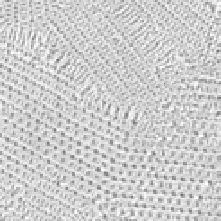Biomedical Engineering Reference
In-Depth Information
plane is seen clearly at the free surface. Electrochemical synthesis
of hydrated Ti(IV) oxide was performed from a 0.2M aqueous TiCl
3
at pH 2.7 using a protocol developed by Kavan
et al.
[92], with the
methanol to ensure wetting of pores. The filled
templates were subsequently heated to 500
addition of 20%
vol
°
C for 2 h. This treatment
served two purposes: to crystallize the deposited material to form
nanocrystalline TiO
2
and to burn away the polymer template. The
resulting films were transparent and optically smooth. Such uniform
replication reflects the uniform cross-film percolation of the pore
networks from surface to substrate.
(a)
(b)
(c)
(d)
Figure 2.18
Electrochemical replication of Ti(IV) oxide in porous gyroid
templates. (a) Surface and (b) cross-sectional SEM images of porous gyroid
PFS templates after removal of the minority PLA component. (c) Surface
and (d) cross-sectional SEM images of the Ti(IV) oxide inverse gyroid array
by uniformly filling the template voids from the conducting substrate by
electrochemical deposition and dissolving the surrounding template in
organic solvent. (a,b,c) image size 1μm, (d) image width 3 μm. Reproduced
with permission from Ref. [61].
An indication of the extremely high fidelity of electrochemical
gyroid replication is given by comparison to computer-simulated
sections of the BCP template before deposition, and of the replicated
material after final removal of the template (Fig. 2.19). A gyroid
simulation with a unit cell dimension of 47 nm was used to match
these SEM images.













Search WWH ::

Custom Search